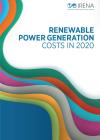

-
-
IRENA (2021), Renewable Power Generation Costs in 2020, International Renewable Energy Agency, Abu Dhabi.
Copied
/-/media/Files/IRENA/Agency/Publication/2021/Jun/IRENA_Power_Generation_Costs_2020.pdf
Copied
Renewable Power Generation Costs in 2020
Newsletter
The decade 2010 to 2020 saw renewable power generation becoming the default economic choice for new capacity. In that period, the competitiveness of solar (concentrating solar power, utility‑scale solar photovoltaic) and offshore wind all joined onshore wind in the same range of costs as for new capacity fired by fossil fuels, calculated without financial support. Indeed, the trend is not only one of renewables competing with fossil fuels, but significantly undercutting them, when new electricity generation capacity is required.
See the interactive infographic on how Low Renewable Costs Allow To Power Past Coal.
Between 2000 and 2020, renewable power generation capacity worldwide increased 3.7‑fold, from 754 gigawatts (GW) to 2 799 GW, as their costs have fallen sharply, driven by steadily improving technologies, economies of scale, competitive supply chains and improving developer experience. Costs for electricity from utility-scale solar photovoltaics (PV) fell 85% between 2010 and 2020.
Other highlights include:
- In 2020, the global weighted-average levelised cost of electricity (LCOE) from new capacity additions of onshore wind declined by 13%, compared to 2019. Over the same period, the LCOE of offshore wind fell by 9% and that of utility-scale solar photovoltaics (PV) by 7%.
- Renewable power generation costs have fallen sharply over the past decade, driven by steadily improving technologies, economies of scale, competitive supply chains and improving developer experience. Costs for electricity from utility-scale solar photovoltaics (PV) fell 85% between 2010 and 2020.
- The cost of electricity from solar and wind power has fallen, to very low levels. Since 2010, globally, a cumulative total of 644 GW of renewable power generation capacity has been added with estimated costs that have been lower than the cheapest fossil fuel-fired option in each respective year. In emerging economies, the 534 GW added at costs lower than fossil fuels, will reduce electricity generation costs by up to USD 32 billion this year.
- New solar and wind projects are increasingly undercutting even the cheapest and least sustainable of existing coal-fired power plants. IRENA analysis suggests 800 GW of existing coal-fired capacity has operating costs higher than new utility-scale solar PV and onshore wind, including USD 0.005/kWh for integration costs. Replacing these coal-fired plants would cut annual system costs by USD 32 billion per year and reduce annual CO2 emissions by around 3 Gigatonnes of CO2.
IRENA’s cost analysis programme has been collecting and reporting the cost and performance data of renewable power generation technologies since 2012. The two core sources of data for the cost and performance metrics contained in this report are the IRENA Renewable Cost Database and the IRENA Auctions and Power Purchase Agreement (PPA) databases. This year, for the first time, the report also includes a snapshot of IRENA’s cost data for behind‑the‑meter battery storage and solar thermal technologies for industrial heat.
Along with reviewing overall cost trends and their drivers, the report analyses cost components in detail. The analysis spans around 20 000 renewable power generation projects from around the world, along with data from 13 000 auctions and power purchase agreements for renewables.




